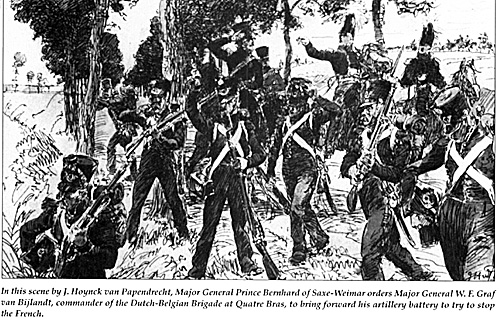On 30 November 1813, taking advantage of Napoleon's disastrous defeat at Leipzig the previous month, Prince William Frederick of Orange landed in the fisherman's town of Scheveningen from his exile in England and was proclaimed sovereign King of the Netherlands. One of the first acts of King William was to raise an army for the United Kingdom of the Netherlands to take control of the remaining territory still occupied by French troops. (Although the term "Netherlands" is historically correct, most English histories call the army Dutch-Belgian and distinguish their military formations as either Dutch or Belgian for clarity.) Napoleon's multinational Grande Armee which invaded Russia in 1812 included a large contingent of Dutch troops. So many Dutch soldiers perished in that disastrous campaign that not enough veteran cadres could be found for King William's new Netherlands army, so he resorted to the expedient of drafting a national militia. While William slowly consolidated his control, the French were driven out of Belgium by Prussian and Austrian troops.
After Napoleon's abdication in April 1814, the victorious Allied powers of Russia, Austria, Prussia, and Great Britain met in Vienna to redraw the map of Europe in their favor. At the Congress of Vienna, Britain lobbied for a strong buffer state on the northern border of France. This area included the former United Provinces (the Netherlands) and the old Austrian Netherlands (the province of Belgium within France's expanded borders). When the Allies' intentions became clear, King William sent his son, the Prince of Orange, to Belgium in order to take over the governorship from the Austrian authorities.
As early as September 1814, while the Congress of Vienna was still embroiled in sometimes bellicose negotiations, efforts were made to raise Belgian regiments that could be incorporated into the Netherlands army. By the end of 1814, the United Netherlands army consisted of some 30,000 men, a third of them Belgian. When Napoleon escaped Elba and returned to the throne in March 1815, the Allied monarchs and their diplomatic representatives were still in Vienna. Thus, suddenly unified, they were able to respond quickly to this resurgent threat and mobilized their armies for a new war. On 11 March 1815 King William ordered a general mobilization. The Netherlands troops were organized into a field army which took up cantonments in southern Netherlands (Belgium) and came under the command of the Duke of Wellington. Every month, reinforcements arrived from Britain and Germany. By June 1815, Wellington's Anglo-Allied army consisted of two infantry corps, one cavalry corps, and a reserve.
The I Corps was under the command of the Prince of Orange and consisted of four infantry divisions: the 1st British Division under Major General George Cooke; the 3rd British Division under Lt. General Count Alten; the 3rd Dutch-Belgian Division under Lt. General Baron Chasse; and the 2nd Dutch-Belgian Division under Lt. General Baron de Perponcher-Sedlnitzky.
The 2nd Dutch-Belgian Division consisted of two brigades. Major General Prince Bernhard of Saxe-Weimar's 2nd Brigade had three battalions of the 2nd Nassau Line Regiment; two battalions of the Orange Nassau Regiment #28; one company of Nassau light infantry (jagers); and Captain Stevenart's (Belgian) Foot Battery with eight guns. (Nassau was a small German duchy along the Rhine.)
Our focus is on the 2nd Division's 1st Brigade under the command of Major General W. F. Graf van Bijlandt (often spelled Bylandt). This brigade consisted of a battalion of the 7th (Belgian) Line Regiment, under the command of Lt. Colonel van den Sande; the 27th (Dutch) Jager Battalion, under the command of Lt. Colonel Grunenbosch (the jagers are sometimes referred to as "chasseurs"); the 5th (Dutch) Militia Battalion, under the command of Lt. Colonel Westenberg; the 7th (Dutch) Militia Battalion, under the command of Lt. Colonel Singendonck; the 8th (Dutch) Militia Battalion, under the command of Lt. Colonel de Jongh; and Captain Bijleveld's (Dutch) Horse Battery with eight guns. Including the artillery, the brigade totaled 3,344 men.
Obviously, the bulk of the brigade was made up of militia who were not regarded as good troops. Composed mostly of young recruits, the militia battalions had only been under arms for a few months. The line battalion, on the other hand, counted many of Napoleon's veterans among its ranks. Lieutenant Scheltens of the 7th Line remarked at his arrival in the barracks that "the battalion was well composed; nearly all officers had served and had campaign experience. The cadre of subaltern officers and corporals was acceptable, but they were in need, just like the soldiers, of practical lessons. All of them were volunteers." (Vicomte Charles Terlinden, Souvenirs d'un Grognard Belge, les memoires du Colonel Scheltens, page 195.)

More Cowards at Waterloo?
-
Introduction
The United Kingdom of the Netherlands Is Created
15 June: The French Advance
16 June: First Experience of Battle
17-18 June: Retreat to Waterloo and Infamy
Response to British Allegations by Renard
Combat Losses: Bijlandt and Allied (slow: 316K)
Back to Table of Contents -- Napoleon #16
Back to Napoleon List of Issues
Back to MagWeb Master Magazine List
© Copyright 2001 by Napoleon LLC.
This article appears in MagWeb (Magazine Web) on the Internet World Wide Web.
The full text and graphics from other military history magazines and gaming magazines are available at http://www.magweb.com
Order Napoleon magazine direct